News
4 principles to help determine direction when going to the forest or climbing mountains
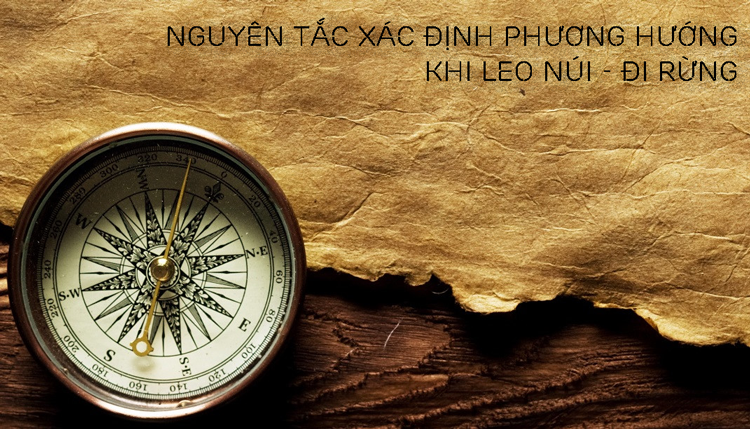
This article provides 4 basic principles of determining direction used in mountain climbing, jungle trekking, especially in necessary survival situations.
- Use a compass to determine direction
- Using the sun to determine direction
- Using the moon to determine direction
- Orientation by plants in the forest
Principle 1: Use a compass to determine direction
Using an iron is the first method mentioned because it is easy to do and can be prepared well in advance.
However, in any method of determining direction, you need to know “which direction is what”, or simply which direction to get out of the forest.
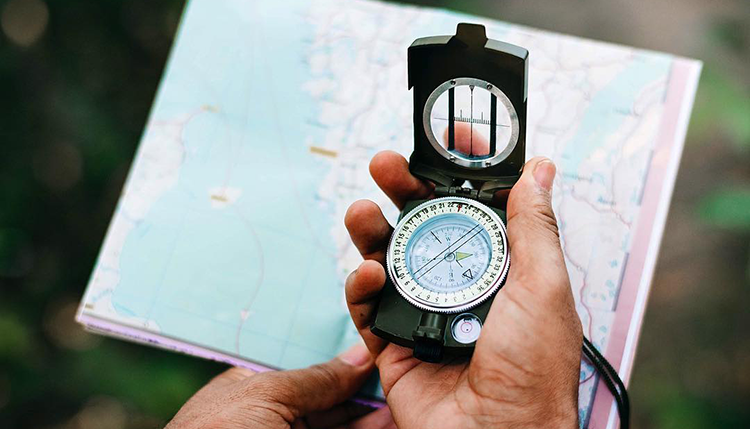
Here are some notes when using a compass to determine direction:
- To level the compass: To increase compass accuracy, some compasses will have a glass bubble that helps you easily determine if you have leveled the compass.
- Use the compass away from metal: For the compass to be accurate, we should stay away from metal objects because the compass has a magnet so it is easily affected by metal objects, especially iron. Therefore, before looking at the compass, you should remove all jewelry made of metal such as rings, necklaces, bracelets, belts or even phones to avoid causing the needle to deviate and point in the wrong direction.
- Do not use the compass near fire: The second thing to note is that you should not place the magnet near fire because the activity of fire will cause the magnet to lose its magnetism and this will also cause the compass needle to deviate, giving incorrect results.
- For areas affected by magnetic fields, compasses should not be used to determine direction. In this case, other methods should be considered.
You can use a Smartphone or GPS instead of a compass, but these tools need batteries to operate, so it’s best to prepare a compass!
Principle 2: Use the sun to determine direction
1. Observe the sun
- Morning: The sun rises in the East.
- Afternoon: The sun sets in the west.
- Noon: The sun is directly overhead.
But that is just a basic and inaccurate way of determining. If you want to know exactly, you should equip yourself with the following knowledge:
in fact, the rising and setting positions of the sun during the year are not fixed but change in cycles: Spring Equinox, Summer Solstice, Autumn Equinox, Winter Solstice.
- On summer solstice days the sun rises in the northeast and sets in the northwest.
- During the winter solstice, the sun rises in the southeast and sets in the southwest. At noon, the sun is not directly overhead but instead shifts to the south, at which point the shadow of an object will fall to the north.
However, this method is not very accurate and is too theoretical.
2. Use a watch with hands
The principle of this method is based on the phenomenon of the Sun rising and setting with respect to the Earth, forming a circle around the Earth, in 24 hours. The hour hand of a clock rotates a circle in 12 hours, meaning that in the same time, the clock hand marks an arc that is twice as large.
If your location is in the Northern Hemisphere:
- Step 1: First, place the analog watch in the palm of your hand or wear it on your wrist so that the watch face is facing up and parallel to the ground.
- Step 2: Then you turn your body so that the hour hand points towards the sun.
- tips:Tip: If you have difficulty adjusting the clock hands to point towards the sun, you can stick a stick (small, narrow) perpendicular to the ground and mark the position of the shadow of the stick with a stone. Then, draw a straight line from the stone to the base of the stick (the position where the stick intersects the ground). Next, you place the clock so that the hour hand is parallel to the line you just drew and the hour hand points towards the stick.
- Step 3: Draw a straight line through the center of the clock, so that this line bisects the angle created by the hour hand and the line connecting the center of the clock with the number 12 (12 o’clock mark) on the clock face. This line will indicate the North – South (N – S) direction.
If you are not sure which direction is North and which is South, just remember that the sun rises in the East and sets in the West. In the Northern Hemisphere, South will be between the number 12 and the hour hand.
If your location is in the Southern Hemisphere
- Step 1: Similar to the way to determine direction in the Northern Hemisphere, you need to place the watch in the palm of your hand or wear it on your wrist so that the watch face is facing up and parallel to the ground.
- Step 2: Turn your body so that the number 12 (12 o’clock mark) points towards the sun.
- Step 3: Draw a straight line through the center of the clock, so that this line bisects the angle created by the hour hand and the line connecting the center of the clock with the number 12 on the clock face. This line will indicate the North-South direction.
If you are not sure which way is north and which way is south, just remember that the sun rises in the east and sets in the west. In the southern hemisphere, north is between the number 12 and the hour hand.
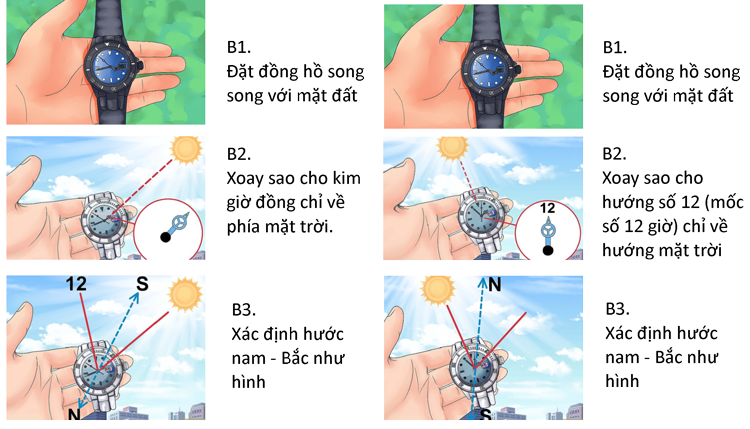
Note:
– In the Southern Hemisphere, North is between 12 and the hour hand.
– If you are using a watch that is set to daylight saving time, use 1 o’clock instead of 12 o’clock in step 3.
– This method only works with analog watches, not digital watches. Your analog watch needs to be accurate and this method has a margin of error, so the direction is only approximate.
3. Use sun shade
How to do as follows:
Prepare a stick, and some stones to mark
Step 1: Choose a flat, non-bush place, prepare: 1 stick about 0.5-1m high, 2 stones.
Step 2: Drive the stake vertically and determine the shadow of the stake, place the first stone at the top of the shadow and mark “West”
Step 3: Wait about 20 – 30 minutes, the top of the stick’s shadow will move to a new position, use the remaining stone to mark “East”
Step 4: Connect the 2 points, you get the West-East direction line
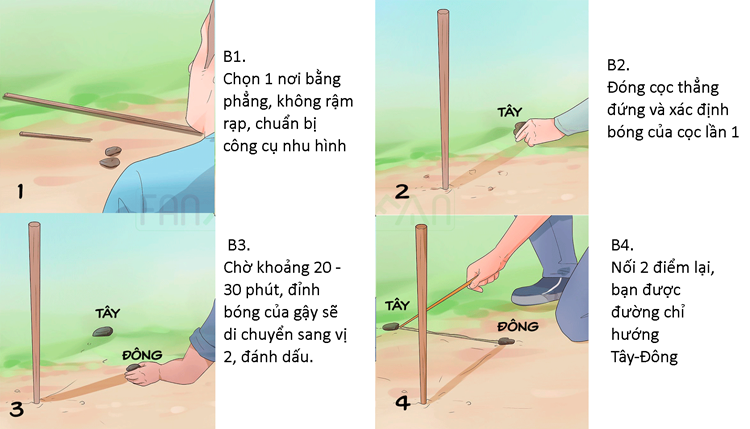
P/s: This is a tip so errors are inevitable. Prepare for use in special cases. It’s best to be well prepared before each trip and remember to prepare a compass!
Principle 3: Use the moon or evening star to determine direction.
1. Moon
At night, if there is a moon, the position of the moon in the sky can help us determine direction. Because the moon is also on the Hoang Doi line, it seems to rise in the East and set in the West like the Sun. However, the moon is different from the sun: sometimes it is full and sometimes it is waning, so determining direction is also a little different. There is a folk saying:
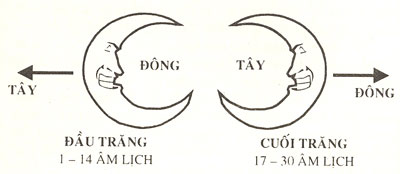 |
(West here means West direction) |
That is, based on the days before the full moon of the lunar calendar (from the 1st to the 14th of the lunar calendar), the waning part of the moon will point to the East.
On the full moon day, you can observe the full moon shining brightly in the sky all night long. You can use the “Owen Doff method” to determine the direction.
On the days after the full moon (from the 17th to the 30th), the crescent moon will point to the West.
2. Evening Star
The Evening Star and the Morning Star are actually one and the same. It is Venus. The second planet closest to the Sun in our Solar System.
Because it is so close to the Sun, from Earth, it appears very bright and often appears “close” to the Sun at dawn and dusk.
When Venus rises around dusk (after the Sun has just set), it is called the Evening Star, located in the West.
And when Venus rises at dawn (before the Sun rises), it is called the Morning Star, located in the East.
Principle 4: Determine direction by plants in the forest
If there is no compass, no Sun, no Moon… then we have to use some classic methods of some forest people like. Although the level of accuracy is not high, it also helps the lost person to feel secure and calm and find the way back.
- Sunflowers always face East, that’s why they are called Sunflowers (facing the rising sun).
- The distinctive shapes of tall tree trunks in dense forests always orient themselves towards the rising Sun to catch the sunlight.
- In tropical-equatorial regions, mosses (or lichens that grow symbiotically) grow on tree trunks on the west side a lot. In temperate regions, mosses grow on the north side.
- The bush grows well in the months with the Northeast wind (cold wind), when there are many birds flying from the direction, under the tree there is a lot of bird droppings is the Southwest direction.
- The leaves of the large stem (the stem if cut across) will point north.
- Based on the flight direction of birds: Winter usually flies south to migrate, Summer usually flies north
- Bamboo shoots and banana shoots usually grow larger in the East direction first, and smaller in other directions later.
- Ant nests: cover many leaves facing North (including ant nests on trees and underground. Except in low places, no rain, little wind).
- The hole of the beehive, the bird nest in the tree is usually in the Southeast direction.

